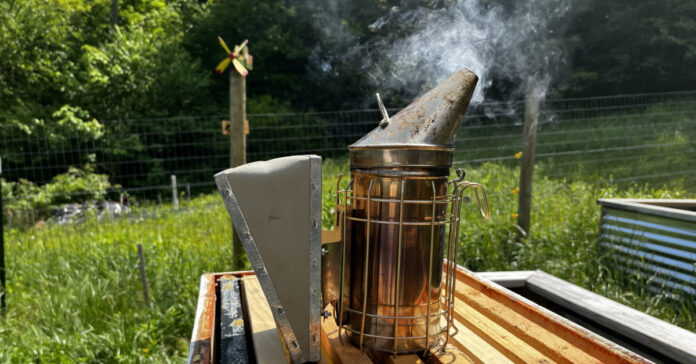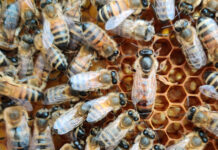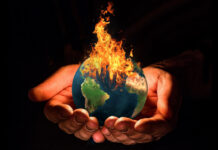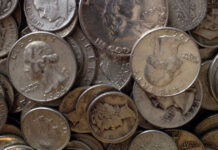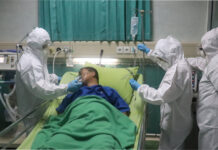Last year, I harvested honey on June 17, again in mid-July, and then in late August. This year, we won’t have enough honey in the hives to harvest on Father’s Day weekend. I’m hopeful we have enough for the first weekend in July.
Last year, I had to harvest in July because the bees were making so much honey I was running out of supers. I ordered extra frames and built extra boxes, but the bees filled them up. The tremendous surge in honey production between 2021 and 2022 caught me by surprise. My solution was to harvest in mid-July and put the empty supers back on the hives for the bees to refill. And they did.
Early this year, I built even more supers and frames. And what happens? We get less honey. I blame the weather.
A poor spring honey flow means I have to cross my fingers and hope things improve. Because I harvested in July and August last year, there is still plenty of time to get a decent crop of honey, but I am not expecting a great crop.
The Good News
While the cold March, the slow spring, and the damp weather have interfered with the normal honey flow, all seven hives finally have queens. The one hive that seemed to resist my efforts to re-queen it had young brood, larvae and eggs in it, meaning it is now queenright. The mother of the new queen is one of my strongest, so I have hopes for a quick build up and recovery. With any luck, this hive will build its strength and be filling supers within six weeks.
This is the first year in which I didn’t buy any nucs, bees, or queens. One of my hives died in the March cold snap, and I split two, so I now have seven hives, one more than last year. I also have three new queens. I consider this growth proof that I can sustainably keep bees, replacing dead hives with my own splits and re-queening hives using my own resources. It may not be as productive as buying queens, but it is sustainable. As a prepper, I want the ability to produce honey for years without any outside inputs.
Yes, there can be benefits to occasionally introducing new genetics, but my queens are from at least three different sources, so there should be some diversity. Plus, if there are any feral hives in the area, their drones may have contributed some sperm when the new queens were on their mating flight, giving my bee yard some additional genetic diversity. In any case, I wouldn’t expect to see problems with inbreeding for multiple generations of queens.
Crossing my Fingers and Making Plans
I had been hoping to exceed last year’s harvest of 240 pounds of honey, but I think that will be a challenge given the late start to the season and the fact that three or four of my hives aren’t as strong as I would like. I will be happy to harvest anything over 200 pounds and have seven strong hives going into 2024. That should help me produce more honey next year.
Next year, I plant to embrace the idea of a “nuc battery,” which means having a couple small hives where you raise new queens and keep them on standby. Then, if you split a hive or if I queen dies, you just add the queen from the nuc. By having a queen ready, you save the 38 to 45 days it takes for a queen to be born, get mated, lay egg, and for the eggs to hatch.
I can see the ability to graft my own queens would be a worthwhile skill to learn in the future. If I had 20 hives, I’d might do it. With less and a dozen, I hope the nuc battery will alleviate that need.
What a Difference some Altitude Makes
I was watching the Canadian Beekeeper on YouTube the other day, and he said it was 36°C, which is about 97°F. How can it be 97° in Canada when we are still in the low 70s here? He’s in Manitoba, which is North of North Dakota and Minnesota. I can only chalk it up to him being located on the plains while we are on the cold side of a mountain. They get longer, colder, snowier winters; I guess they get hotter and possibly longer summers, too.
Makes me glad I live in the Appalachians.
By the way, the Canadian Beekeepers is the man behind the nuc battery idea. I don’t know if he came up with it himself, but he uses it and has promoted it on YouTube and in talks at beekeeper meetings.
Beekeeping for Preppers
Beekeeping is an excellent skill for preppers to develop and you can raise bees in the city, often under the radar. I recommend preppers have a minimum of four to six hives, which will give a decent beekeeper enough stock to be self-sustaining. There’s nothing wrong with having ten or more hives; I know beekeepers with 20 or 30 hives, but that much equipment gets expensive. If you are looking for an inexpensive hive design, search online for “Plans for the Comfort Hive,” which was created by Sam Comfort, who is an innovative beekeeper. I would build his hives after the SHTF.
More hives also means more time spent in the bee yard, which is time away from something else. This most recent inspection of seven hives took only 90 minutes, but at other times of year, I can spend three hours in the bee yard. If you come to enjoy beekeeping or like the money you can make selling 1,000 pounds of honey, then go for it, but don’t spend too much time raising bees at a the expense of some other prepping priority.
I sell my excess honey now. Between it and our eggs, I am grossing around $200 a month. Not much, but it gives me some spending money. In a post-SHTF world, we would consume more honey than we do now, and it would be useful for barter.
Calories from Honey
From a survival food and sustenance perspective, 200 pounds of honey is 276,000 calories. If you have a family of four, that’s 2.2 ounces of honey per person per day, or about 190 calories. That would provide a welcome caloric boost in a survival situation. In a good year, when the hives are optimized and the weather cooperates, I could potentially harvest over 400 pounds of honey from seven hives. For beekeepers in warmer parts of the country, the harvest would be higher. However you measure it, a renewable source of honey is a nice addition to your prepper plans.
If you can’t make your own, buy raw honey and store it. Honey lasts forever. If yours crystallizes, put the jar in a pot of warm water and it will re-liquefy.
Garden Update
Elsewhere on the homestead, the garden is doing better than it was our last update. The warmer weather is helping, and unlike the bees, the garden likes the rain. The plants that my wife started indoors have all been transplanted outdoors. We had so many, she has given away some plant starts. She also has her herb garden in.
The open pollinated Provider bush beans we bought from Jackie Clay’s Seed Treasures all germinated and are growing well. The toughest part of gardening for me is when the time comes to thin the plants. I just want to let them all grow, but that makes for a crowded garden and the plants compete with each other.
The New Chicks
We moved all ten of the new chicks outside. They are in a portion of the chicken run and are transitioning from chick feed to grower feed. A fence separates them from the rest of the flock, and the chicks and still sleep in the plastic dog crate. The chickens have shown some curiosity about the chicks and visit through the fence.
When the young chickens grow larger, I will merge them with the existing flock. My biggest challenge is how to keep each group eating their own feed. The chicks should be eating grower feed, and the hens should be eating layer pellets. The latter have excess calcium to help the birds make egg shells. I understand the excess calcium can give non-laying birds kidney problems, but my roosters have been eating it for two years and seem just fine.
We were relieved to put them outdoors. It is nice to go into the garage and no longer smell chicken poop.

